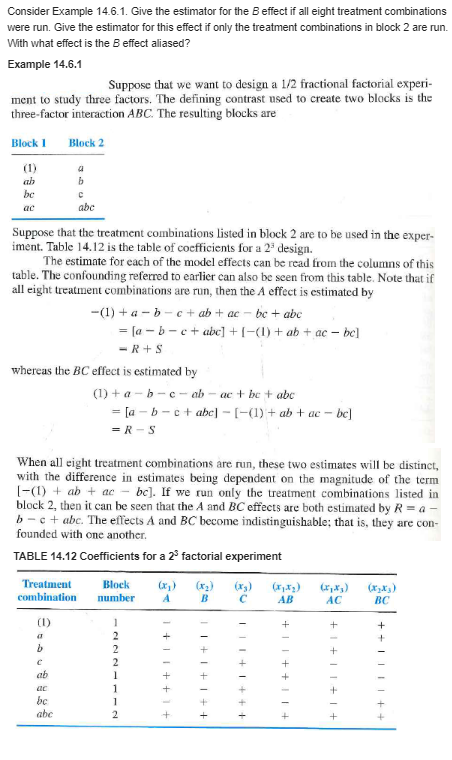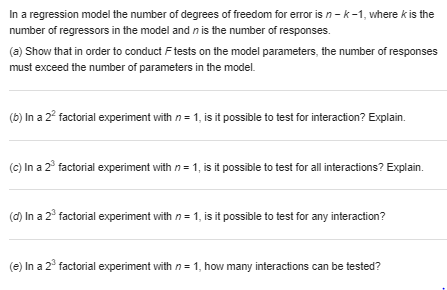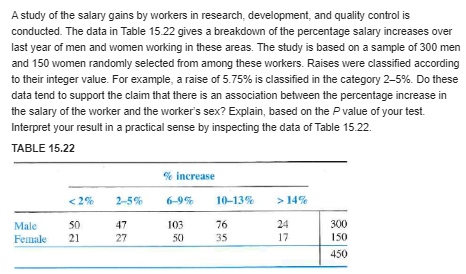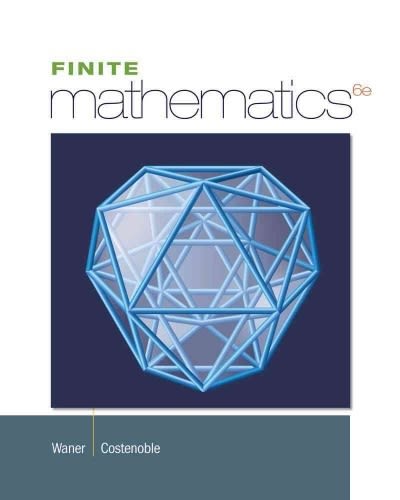Correct Computation:-
Consider Example 14.6.1. Give the estimator for the B effect if all eight treatment combinations were run. Give the estimator for this effect if only the treatment combinations in block 2 are run. With what effect is the 8 effect aliased? Example 14.6.1 Suppose that we want to design a 1/2 fractional factorial experi- ment to study three factors. The defining contrast used to create two blocks is the three-factor interaction ABC. The resulting blocks are Block 1 Block 2 be C ac abc Suppose that the treatment combinations listed in block 2 are to be used in the exper- iment. Table 14.12 is the table of coefficients for a 23 design. The estimate for each of the model effects can be read from the columns of this table. The confounding referred to earlier can also be seen from this table. Note that if all eight treatment combinations are run, then the A effect is estimated by -(1) +a - b - c+ ab+ ac - be + abc = [a - b - c+ abc] + [-(1) + ab + ac - be] -R+S whereas the BC effect is estimated by (1) +a- b - c- ab - ac + be + abc = [a - b - c + abc] - [-(1) + ab + ac - be] = R - S When all eight treatment combinations are run, these two estimates will be distinct, with the difference in estimates being dependent on the magnitude of the term [-(1) + ab + ac - be]. If we run only the treatment combinations listed in block 2, then it can be seen that the A and BC effects are both estimated by R = a - b - c + abc. The effects A and BC become indistinguishable; that is, they are con- founded with one another. TABLE 14.12 Coefficients for a 2 factorial experiment Treatment Block (rj ) (x2) combination number A B C AB AC BC (1) 1 + + II+ b II+ ++I+Itll ab +l+ +1 1+ + +II+1 +++1+1 +ll++ bc abcIn a regression model the number of degrees of freedom for error is n - k-1, where k is the number of regressors in the model and n is the number of responses. (a) Show that in order to conduct F tests on the model parameters, the number of responses must exceed the number of parameters in the model. (b) In a 2" factorial experiment with n = 1, is it possible to test for interaction? Explain. (c) In a 2" factorial experiment with / = 1, is it possible to test for all interactions? Explain. (d) In a 2* factorial experiment with n = 1, is it possible to test for any interaction? (e) In a 2" factorial experiment with n = 1, how many interactions can be tested?\f\f\fIt is assumed that the labor pool for a particular industry consists of 40% white males, 30% white females, 5% black females, 15% black males, and 10% others. Ideally the work force should reflect these percentages. To see if this is the case, a random sample of 200 workers is selected and each worker is placed into exactly one of the above categories. If the work force reflects the labor pool, how many workers are expected in each category? When the sampling is complete, it is observed that there are 95 white males, 50 white females, 2 black females, 20 black males, and 33 others employed. Do these data lead you to suspect that the work force does not reflect the percentages in the labor pool very well? Explain.A random digit generator should produce the digits 0 to 9 inclusive with equal probability. If such a generator is activated 100 times, how many of each digit is expected? If we observe 10 zeros, 8 ones, 9 twos, 11 threes, 12 fours, 7 fives, 10 sixes, 13 sevens, 9 eights, and the rest nines, do you think that there is reason to suspect that the generator does not produce the digits with equal frequency in the long run?\f\f















